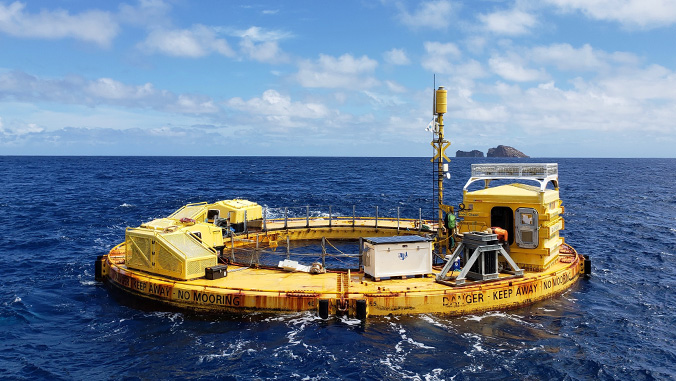
A new infusion of $6 million from the Naval Facilities Engineering Command, and Expeditionary Warfare Center will allow the Hawaiʻi Natural Energy Institute (HNEI) at the University of Hawaiʻi at Mānoa, to continue to provide critical research and logistical support to the only grid-connected wave energy testing site in the nation. The U.S. Navy’s Wave Energy Test Site (WETS), off Marine Corps Base Hawaiʻi provides a unique proving ground for pre-commercial wave energy converters (WECs) to demonstrate performance in an operational setting and advance their technology readiness level.
Marine energy has immense potential to supply persistent power to ocean observing and monitoring, desalination, aquaculture, at-sea mineral scavenging, and electrification of remote or island communities.
“We are excited by the Navy’s latest investment in our work to advance wave energy through our support of WETS, particularly as it allows us to expand our research into new areas of relevance to offshore applications, such as autonomous vehicle recharge for ocean observing purposes,” said Pat Cross, research specialist in marine energy at HNEI and principal investigator for the WETS support program.
These funds, directed to the Applied Research Laboratory at UH, working with HNEI, will allow the university to support a number of WEC deployments planned in the 2021 to 2024 timeframe in the form of environmental monitoring, power and survivability performance assessment, and additional logistics support to the Navy and to WEC developer companies.
Funds expand UH research
In addition to core support to WETS, the new funds will support an expansion of UH research related to offshore, non-grid-connected applications of wave energy.
HNEI will examine the potential for existing WETS infrastructure to support the creation of an offshore test and demonstration node, including subsea power storage as well as communications and power interfaces that would allow smaller-scale WECs to recharge autonomous undersea vehicles (AUVs) and various environmental sensing systems. The team will also design an AUV docking and charging station for use at WETS.
The new funding further supports HNEI and UH researchers to advance a number of research projects such as a power generation and management system for a floating Oscillating Water Column WEC, designed for applications such as ocean observation, navigation and equipment recharge. A novel breakwater system will also be advanced with an integrated WEC that will generate power from wave energy while protecting coastal regions. Additionally, the team will develop a small-scale WEC that can be rapidly deployed for both power generation and seawater desalination close to shore.
Hawaiʻi’s progress in making the transition to renewable energy for electric power is well-served by development of wave energy, given the availability of that resource in the state and its potential to augment and complement other forms of variable renewable energy—specifically wind and solar. Wave energy is relatively consistent throughout the day and night, and can be forecast with precise accuracy a week or more in advance, enhancing grid managers’ ability to plan for its contribution to the overall generation mix on the grid.
This effort is an example of UH Mānoa’s goal of Excellence in Research: Advancing the Research and Creative Work Enterprise (PDF), one of four goals identified in the 2015–25 Strategic Plan (PDF), updated in December 2020.

